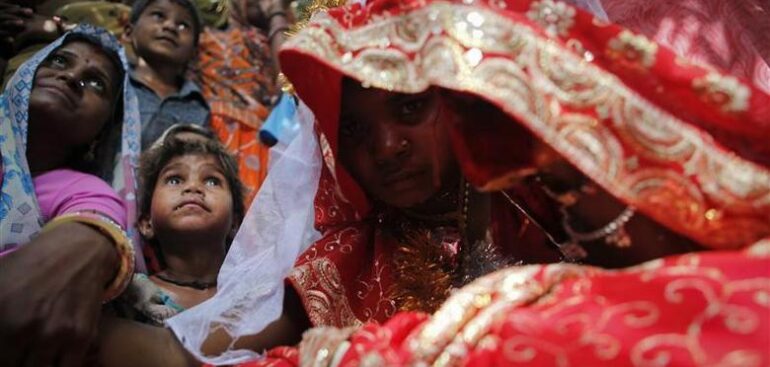Salma (name changed) was just a child, only 15 when her world changed forever last summer. In the heat of the southern Sindh province of Pakistan, in the remote Dadu district, she was married off to a man twice her age. The monsoon season was on the horizon, bringing with it the ominous threat of floods that had already devastated their lives once before.
Her family couldn’t forget the nightmare of 2022 when relentless rains swallowed a third of Pakistan, displacing millions and wiping out their only source of income. They had already been torn from their home, and her father, Allah Bukhsh, had lost his livelihood as an agricultural worker. With no means to provide for his family, the harsh reality of survival left him with an impossible choice: to marry off his young daughter in exchange for 200,000 Pakistani rupees (€650/$720).
“We decided to avoid the monsoon rains and suffering in the camps,” Bukhsh said, his voice heavy with guilt. “It is not an easy thing to do.”
Salma, full of dreams and innocence, was initially “happy to be married,” hoping perhaps for a new beginning. But life as a bride, especially one so young, quickly revealed its harshness. Now, just 16, she is already a mother. Holding her newborn close, she whispers, “My responsibilities have doubled now.”
In the heart of Pakistan, in regions torn apart by poverty and disaster, young girls are not just losing their childhoods—they are losing their futures. Child marriages have become an all-too-common story in this Islamic nation, where survival often outweighs the dreams of the young. According to government data, Pakistan tragically ranks as the sixth-highest in the world for the number of girls married before the age of 18.
The legal age for marriage, which ranges from 16 to 18 depending on the region, remains a distant formality, rarely enforced in the chaos of survival. Rights groups are raising alarms, pointing to the brutal reality: extreme weather events, like the monsoon floods, are pushing more and more girls into forced marriages.
Niaz Ahmed Chandio, coordinator of the Child Rights Committee, a local NGO, shared a grim insight: “There are 45 cases of child marriages registered in Dadu in the last year, and I believe there could be dozens more that are not registered.” In these desperate circumstances, marriage is not about love or partnership—it’s a cruel means of survival.
Mashooque Birhmani, founder of the NGO Sujag Sansar, has seen firsthand the devastation these marriages cause. “Poverty and displacement force families to give their daughters away in exchange for money,” he explained. “These are marriages of survival, prompted by the monsoon season. Families marry off their daughters to reduce the burden of feeding another mouth during the climate calamity.”
Attorney Osama Malik echoes this heartbreaking reality. “The floods have been utterly devastating,” he says, “leading to the destruction of crops and livestock. Poor farmers, with no other options, marry off their daughters as soon as they reach puberty.”
In these regions, survival comes at a heavy cost, and for countless young girls, that price is their future.
For years, Pakistan has been making strides, slowly but surely, in reducing the heart-wrenching practice of child marriage. The United Nations Children’s Fund (UNICEF) acknowledged the progress, marking it as a victory for the future of countless girls. But all it took was a catastrophic monsoon season to undo so much of that hard-earned progress. The floods of 2022 were not just waters that drowned homes and crops—they washed away years of hope, leaving behind a path of despair.
“Evidence shows that extreme weather events like this are correlated with an increased risk of child marriage,” UNICEF reported in the aftermath of the floods. It was a sobering realization. “In a year with an event of this severity, we would expect to see an 18% increase in the prevalence of child marriage, equivalent to erasing five years of progress.” Those numbers are not just statistics; they are the shattered dreams of young girls forced into marriage, bearing the burden of survival on their fragile shoulders.
Yet, the Sindh government has denied this tragic reality. “There are no underage marriages taking place in Dadu, and girls getting married are adults, not child brides,” Hidayat Ali Shah, deputy director of the Child Protection Authority in Dadu district, claimed. But the stories of these young girls tell a different, heartbreaking truth—one that echoes throughout rural Pakistan.
In a society where patriarchy reigns supreme, girls are seen as burdens, waiting to be “offloaded” in the form of marriage. “This patriarchal thinking must be addressed through awareness,” said Afia Salam, a journalist focused on environmental and gender issues. The burden of early motherhood, the loss of education, and the bleak prospects of employment paint a bleak future for these child brides. They are trapped in a cycle of dependence, with no path to freedom.
Chandio, from the Child Rights Committee, emphasized the dire need for education—both for parents and communities. “Strengthening and enforcing laws and social security measures from the government and aid groups are key to tackling the issue among vulnerable communities.”
In the end, child marriage is not just a consequence of poverty or climate disaster—it’s a symptom of a society that still fails to see the value in its daughters. But with every voice raised in awareness, there is hope that the tide will turn one day.
